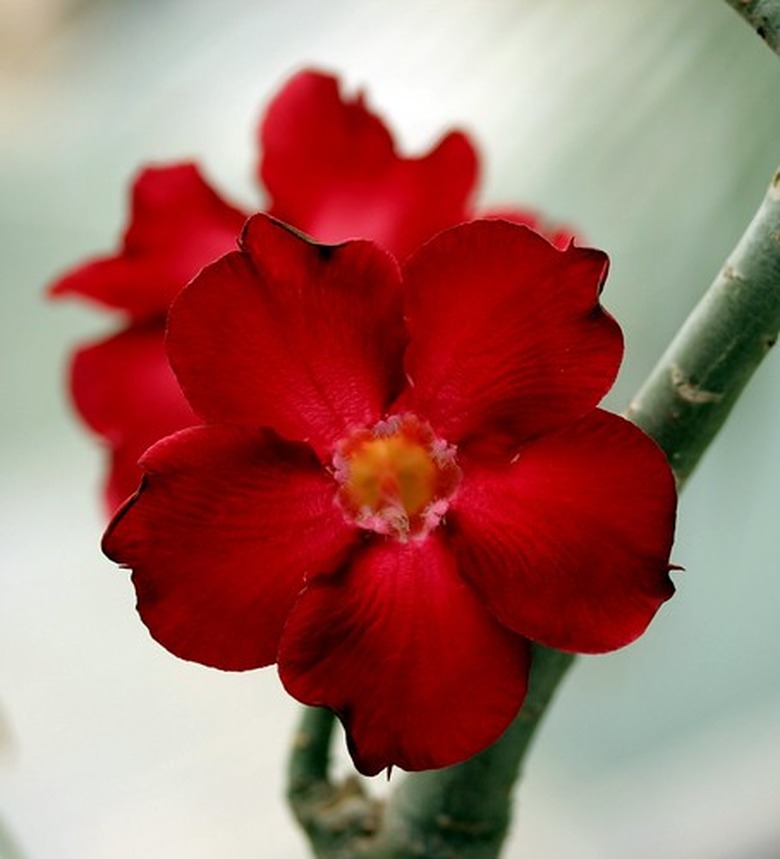The History Of The Franciscan Desert Rose
The desert rose grows in the tropical climates of Africa, Asia, Australia and the Americas. There are many varieties from which have come an array of hybrids. In 1849, the Scottish botanist, Robert Brown named the Australian version Sturtia gossypioides. More recently, it has also been called darling river rose, cotton rosebush and Australian cotton, in addition to desert rose. The desert rose known as Adenium obesum is native to Africa and Arabia, and also goes by several different names. However, there is only one "Franciscan Desert Rose" and it is something of a departure from horticulture, being in the realm of upscale dinnerware.
Dinnerware Pattern
Franciscan Desert Rose is one of the best-selling patterns in the history of American dinnerware. It was introduced in 1941, and was among several highly successful sculpted, embossed and hand-decorated dinnerware patterns manufactured under the Franciscan brand. It portrays the delicate, five-petal desert rose in an elegant shade of pink. The desert rose blooms in pink, red and white, as well as hybrid combinations.
- The desert rose grows in the tropical climates of Africa, Asia, Australia and the Americas.
- More recently, it has also been called darling river rose, cotton rosebush and Australian cotton, in addition to desert rose.
Franciscan Ware
Franciscan dinnerware dates back to 1934 when it was manufactured at a plant in Glendale, Southern California. At first it was called "Franciscan pottery" which by the late 1930s had become "Franciscan ware." The parent company of the Franciscan division was Gladding, McBean and Co., which engaged a husband and wife team, Mary and Frederic Grant (a ceramics engineer), to handle every aspect of the production of its dinnerware. From 1936 through 1952, Mary Grant was Chief Stylist, in which capacity she designed and oversaw the Franciscan Desert Rose dinnerware line.
Collectibles
Today, Franciscan Desert Rose dinnerware is no longer in production in the United States. The plant in Southern California was closed in 1984, after the Franciscan division was bought over by Josiah Wedgwood & Sons, Ltd., in 1979, and production was moved to the United Kingdom. Franciscan Desert Rose dinnerware items with the "Made in USA" backstamp have become sought-after collectibles.
Adenium Obesum
The inspiration for the Franciscan Desert Rose pattern, the Adenium obesum species of desert rose, is part of the Apucynaceae family of plants. It is now available in many countries, and in many new forms, thanks to hybridization. Besides desert rose, it is known by several other names, including sabi star, desert azalea, mock azalea, impala lily and kudu lily.
- Franciscan dinnerware dates back to 1934 when it was manufactured at a plant in Glendale, Southern California.
- The parent company of the Franciscan division was Gladding, McBean and Co., which engaged a husband and wife team, Mary and Frederic Grant (a ceramics engineer), to handle every aspect of the production of its dinnerware.
Sturt's Desert Rose
The current botanical name of the Australian desert rose flower, dating from 1947, is Gossypium sturtianum var. sturtianum, and it is a member of the cotton genus. The Latin "Gossypium" was originally used by Pliny to describe the cotton tree. "Sturtianum" derives from Captain Charles Sturt (1795 to 1869), who discovered the desert rose in central Australia around 1844. Sturt's desert rose is also native to areas of South Australia, New South Wales and Queensland. In 1974, Australia's Northern Territory adopted Sturt's desert rose as its floral emblem.
